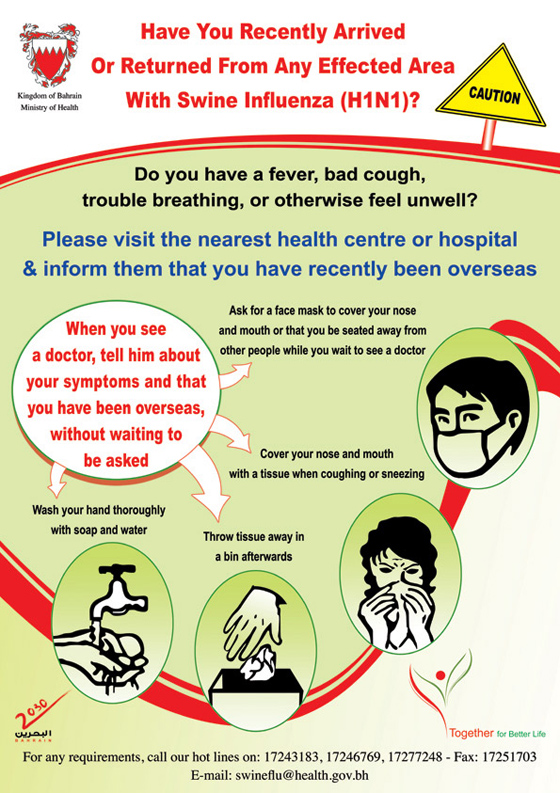
Swine Flu
- About the Disease
- What should you know about Swine Flu (PDF)
- Swine Flu Poster
- Guidelines On Swine Influenza Preparedness For Health Care Workers in Bahrain
- WHO Information Bulletin
- Links
- Hotlines
About the Diseas
What is swine flu?
Like people, pigs can get influenza (flu), but swine flu viruses aren't the same as human flu viruses. Swine flu doesn't often infect people, and the rare human cases that have occurred in the past have mainly affected people who had direct contact with pigs. But the current swine flu outbreak is different. It's caused by a new swine flu virus that has changed in ways that allow it to spread from person to person -- and it's happening among people who haven't had any contact with pigs.
What are swine flu symptoms?
Symptoms of swine flu are like regular flu symptoms and include fever, cough, sore throat, runny nose, body aches, headache, chills, and fatigue. Many people with swine flu have had diarrhea and vomiting. Nearly everyone with flu has at least two of these symptoms. But these symptoms can also be caused by many other conditions. That means that you and your doctor can't know, just based on your symptoms, if you've got swine flu. It takes a lab test to tell whether it's swine flu or some other condition.
Who is at highest risk from H1N1 swine flu?
Most U.S. cases of H1N1 swine flu have been in older children and young adults. It's not clear why, and it's not clear whether this will change.
But certain groups are at particularly high risk of severe disease or bad outcomes if they get the flu:
- Pregnant women
- Young children, especially those under 12 months of age
- People with heart disease or risk factors for heart disease
- People with HIV infection
- People with chronic diseases
- People taking immune suppressing drugs, such as cancer chemotherapy or anti-rejection drugs for transplants
People in these groups should seek medical care as soon as they get flu symptoms.
How does swine flu spread? Is it airborne?
The new swine flu virus apparently spreads just like regular flu. You could pick up germs directly from an infected person, or by touching an object they recently touched, and then touching your eyes, mouth, or nose, delivering their germs for your own infection. That's why you should make washing your hands a habit, even when you're not ill. Infected people can start spreading flu germs up to a day before symptoms start, and for up to seven days after getting sick, according to the CDC.
The swine flu virus can become airborne if you cough or sneeze without covering your nose and mouth, sending germs into the air.
The U.S. residents infected with swine flu virus had no direct contact with pigs. The CDC says it's likely that the infections represent widely separated cycles of human-to-human infections.
How is swine flu treated?
The new swine flu virus is sensitive to the antiviral drugs Tamiflu and Relenza. The CDC recommends those drugs to prevent or treat swine flu; the drugs are most effective when taken within 48 hours of the start of flu symptoms. But not everyone needs those drugs; many of the first people in the U.S. with lab-confirmed swine flu recovered without treatment. The Department of Homeland Security has released 25% of its stockpile of Tamiflu and Relenza to states. Health officials have asked people not to hoard Tamiflu or Relenza
Is there a vaccine against the new swine flu virus?
No. But the CDC and the World Health Organization are already taking the first steps toward making such a vaccine. That's a lengthy process -- it takes months.
How can you prevent swine flu infection?
The CDC recommends taking these steps:
- Wash your hands regularly with soap and water, especially after coughing or sneezing. Or use an alcohol-based hand cleaner.
- Avoid close contact with sick people.
- Avoid touching your mouth, nose, or eyes. That's not easy to do, so keep those hands clean.
- If you feel ill, stay home.
How long does the flu virus survive on surfaces?
Flu bugs can survive for hours on surfaces. One study showed that flu viruses can live for up to 48 hours on hard, nonporous surfaces such as stainless steel and for up to 12 hours on cloth and tissues. The virus seems to survive only for minutes on your hands -- but that's plenty of time for you to transfer it to your mouth, nose, or eyes.
How severe is swine flu?
The severity of cases in the current swine flu outbreak has varied widely, from mild cases to fatalities. Early cases in the U.S. were mild, but there has been at least one U.S. death from swine flu. And it's impossible to know whether the virus will change, either becoming more or less dangerous. Scientists are watching closely to see which way the new swine flu virus is heading -- but health experts warn that flu viruses are notoriously hard to predict, as far as how and when they'll change.
Links
World Health Organization (Regional Office for the Eastern Mediterranean)Centers for Disease Control and Prevention
Hotlines
Tel: (+973) 17243183 - (+973) 17246769 - (+973) 17277248Fax: (+973) 17251703
E-Mail: SwineFlu@health.gov.bh



